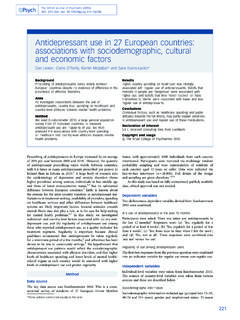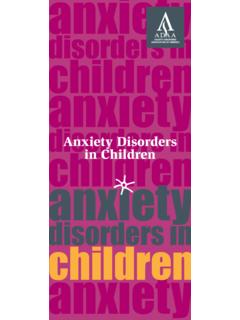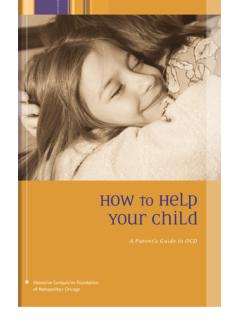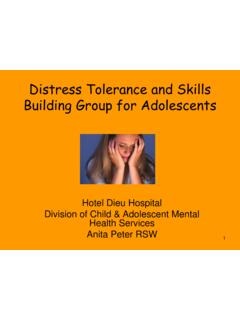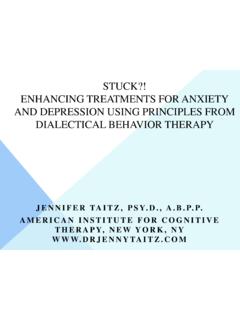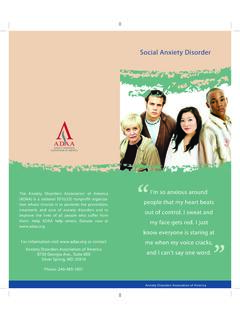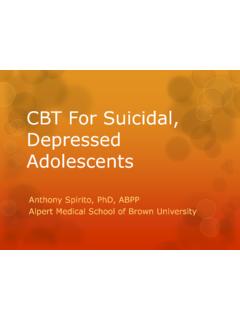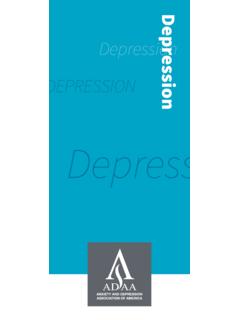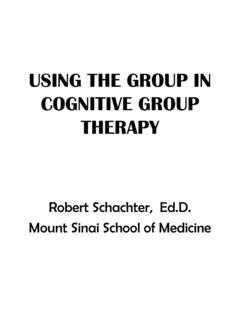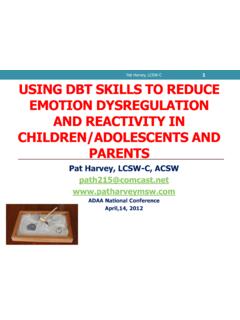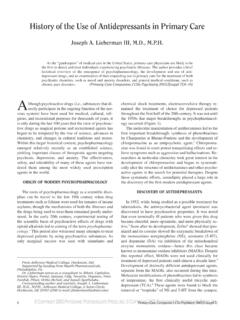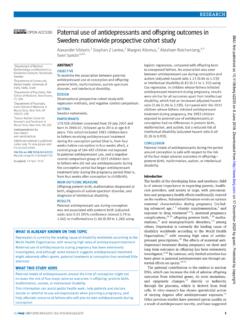Transcription of Anxiety and Depression
1 Anxiety and DepressionYou or someone you know may have been diagnosed with Anxiety and Depression . What do you do next? As you read this booklet, you will learn about Anxiety and depressive disorders, available treatments, and tips for managing symptoms. You are not alone and the Anxiety disorders association of america (adaa) is here to help. Most of us feel anxious or depressed at times. A death in the family, losing a job or home, separation and divorce, financial instability, a severely ill list is endless. Feelings of sadness, loneliness, fear, hopelessness, and Anxiety are normal, and they usually pass over time. But if these feelings interfere with daily activities, you may have an Anxiety disorder or Depression or both. It is not uncommon to have Anxiety and Depression . In fact, about half of those who are diagnosed with Depression are also diagnosed with an Anxiety disorder, and most with Depression experience some Anxiety symptoms.
2 Women are more likely than men to have Depression as well as an Anxiety disorder. Many people with an Anxiety disorder also may experience periods of Depression . Anxiety and Depression are crippling, and they can have profound negative effects on you and your family and friends. They can disrupt your daily activities and affect your ability to care for loved ones and complete tasks related to school or work. These disorders are real and they are serious, but they can be treated together and separately. There is hope, and finding the right treatment will help you get better. Anxiety disordersAnxiety is a normal biological reaction to stress and an important part of living. It helps us get out of harm s way and prepare for important events, and it warns us when we need to take you may experience Anxiety that is persistent, irrational, seemingly uncontrollable, and overwhelming. If it s an excessive, irrational dread of everyday situations, it can be disabling.
3 When Anxiety interferes with daily activities, you may have an Anxiety disorder. The term Anxiety disorder refers to generalized Anxiety disorder (GAD), obsessive-compulsive disorder (OCD), panic disorder, posttraumatic stress disorder (PTSD), social Anxiety disorder (also called social phobia), and specific phobias. Anxiety disorders often run in families and have a biological basis, much like allergies or diabetes. These are real, serious disorders that are Anxiety disorder has specific symptoms. For more details, visit numbers Anxiety disorders: more than 40 million adults in the Major Depression : about million American adultsDysthymia: about million American adultsBipolar disorder: about million American adultsdepression and depressiVe disorders The term Depression often characterizes feelings of being sad, discouraged, hopeless, unmotivated, as well as a general lack of interest or pleasure in life. When these feelings last for a short period of time, it may be called a passing case of the blues.
4 But when they last for more than two weeks and interfere with regular daily activities, it s likely you have a depressive disorder. Research shows that Depression and Anxiety are risk factors for suicide: More than 90 percent of people who commit suicide have a diagnosable mental disorder. Early diagnosis and intervention with appropriate treatment are critical steps to feeling better. Depressive disorders, also known as mood disorders, include three main types: major Depression , dysthymia, and bipolar disorder, and they can occur with any Anxiety Depression involves a combination of symptoms that are disabling and interfere with your ability to work, study, eat, and sleep. It may occur once or twice in your lifetime or more frequently. Or you may experience it in relation to the death of a loved one, a romantic breakup, a medical illness, or other life event. Some people may experience physical aches and pains, leading them to believe that these are symptoms of an undiagnosed physical ailment.
5 Others may feel that life is not worth living, and a small number may attempt to end their lives. Depression is different in each person. No two people experience the same combination, severity, frequency, and duration of symptoms. Symptoms of major depressionPersistent sad, anxious, or empty mood Feelings of hopelessness, pessimism Feelings of guilt, worthlessness, helplessness Loss of interest or pleasure in hobbies and activities, including sexDecreased energy, fatigue, feeling slowed down Difficulty concentrating, remembering, making decisionsInsomnia, early-morning awakening, or excessive sleepingLow appetite and weight loss or overeating and weight gainThoughts of death or suicide, suicide attempts Restlessness or irritability Persistent physical symptoms that do not respond to treatment, such as headaches, digestive disorders, and pain for which no other cause can be diagnosedDysthymia, or dysthymic disorder, is a chronic form of Depression that usually continues for at least two years.
6 Although it is less severe than major Depression , it involves the same symptoms, mainly low energy, poor appetite or overeating, and insomnia or oversleeping. It can show up as stress, irritability, and mild anhedonia, which is the inability to derive pleasure from most disorder, once called manic- Depression , is characterized by moods that shift from severe highs (mania) or mild highs (hypomania) to severe lows ( Depression ). During the manic phase, a person may experience abnormal or excessive elation, irritability, a decreased need for sleep, grandiose notions, increased talking, racing thoughts, increased sexual desire, markedly increased energy, poor judgment, and inappropriate social behavior. During the depressive phase, a person experiences the symptoms of major Depression . Mood swings from manic to depressive are often gradual, although they can also take place Anxiety and depressiVe disorders Anxiety and Depression are highly treatable.
7 Therapy and medications have proved effective in treating Anxiety and depressive disorders, sometimes with a combination of therapies. Talk with your doctor or therapist about the best treatment for you. New scientific research emerges all the time to improve treatments. This booklet gives an overview of current treatments that are proven effective for these disorders. Often Depression and an Anxiety disorder can be treated the same way and at the same time. Treatment should be tailored to your individual diagnosis and designed to help you manage and reduce the symptoms of both disorders. You may have symptoms that require treating one disorder first. The first step is getting the appropriate diagnosis and deciding on a course of treatment that will work for you. therapYSeveral forms of psychotherapy are effective. Of these, cognitive-behavioral therapy (CBT) is a short-term form of psychotherapy that is often very effective.
8 CBT teaches you how to replace negative and unproductive thought patterns with more realistic and useful ones. Treatment focuses on taking specific steps to overcome Anxiety and Depression , often involving facing your fears. Interpersonal therapy (IPT), acceptance and commitment therapy (ACT), and dialectical behavioral therapy (DBT) are also effective types of psychotherapy. Talk to your therapist about which option might be best for you. Find out more about treatment at forms of therapy. In addition to psychotherapy, your doctor or therapist may suggest other studies have shown attention training can be as effective in treating generalized Anxiety disorder and social Anxiety disorder as CBT and medication. Other studies have shown it to be effective in reducing Depression symptoms. Attention training helps patients practice how not to focus on threatening words or on images of threatening therapy uses strategies to reduce the level of distress within a family that may contribute to a person s symptoms or result from them.
9 Relaxation techniques breathing re-training, progressive muscle relaxation, and exercise may help you develop the ability to cope more effectively with the stresses that contrib-ute to Anxiety and mood, as well as physical symptoms. Particularly effective for bipolar disorder is interpersonal and social rhythm therapy. This program stresses maintaining a regular schedule of daily activities and stability in personal re-lationships. People record the timing of their activities, moods, and levels of social stimulation. As treatment progresses, they work to keep stable social rhythms (when to sleep, exercise, eat, etc.), anticipate events that could disrupt rhythms, and develop plans for continued mood and social rhythm are effective. Symptoms of Anxiety and depressive disorders often occur together, and both respond to treatment with selective serotonin reuptake inhibitor (SSRI) and sero-tonin norepinephrine reuptake inhibitor (SNRI) medications.
10 SSRIs and SNRIs have fewer side effects. These medications must be taken for two to four weeks to experience their full effect, and it may take several weeks to adjust the medication to the correct dosage. Even once you are feeling better, you must continue taking the medications. Changes to a different medication or withdrawal from all medication should be only done under your doctor s information about specific medications approved by the FDA, visit My Depression , generalized Anxiety disorder, and social Anxiety disorder have been with me forever. But I am fortunate to have received effective treatment from well-trained professionals, and I got my life back. 6 Medications for bipolar disorder differ. It is important to get a proper diagnosis and discuss treatment options that will lead to a healthy and productive life. Without treatment, bipolar disorder usually gets worse, causing manic and depressive episodes to become more frequent and more severe, and leading to an increased likelihood of substance abuse and suicide attempts.
